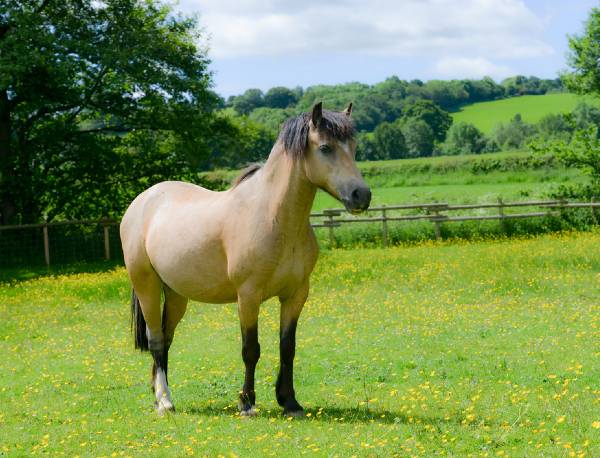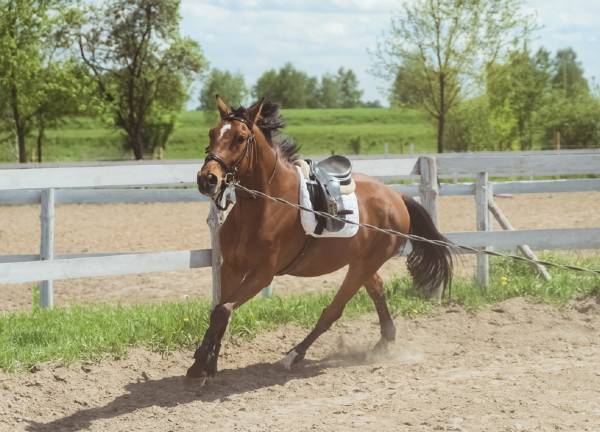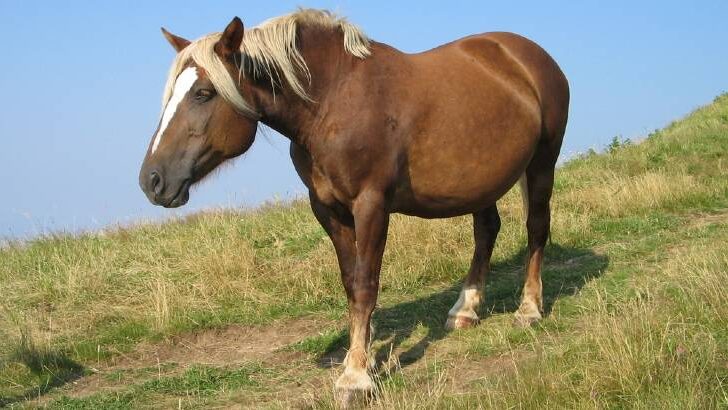Affiliate Disclaimer
As an Amazon Associate I earn from qualifying purchases. It helps me keep the website going. Thank you for your support.
It can be confusing to see a horse with a round belly but prominent ribs. In this article, we will explore the reasons why your horse may be fat but ribby and understand whether your horse’s weight and overall condition is healthy. We’ll also delve into six factors that could be contributing to a ribby appearance even though your horse may have a fat belly. Let’s unravel the mystery of a fat yet ribby horse!
Unpacking a horse’s fat but ribby appearance is best done by understanding the body condition score (BCS) system. Using this system, a horse’s body condition is evaluated on a scale of 1 to 9, with 1 being emaciated and 9 being extremely obese. Ideally, a healthy horse should fall between 4 and 6 on this scale.
Even though it might seem counterintuitive, a horse with a BCS of 4 or 5 can have visible ribs while still being considered healthy. So, if you can see your horse’s ribs, it doesn’t necessarily mean it’s unhealthy.

Understanding More About The Body Condition Score (BCS) System
The Body Condition Score (BCS) system is a widely used method for assessing and quantifying the body fat and muscle condition of horses.
It provides a standardized scale that allows horse owners, trainers, and veterinarians to evaluate and monitor the body condition of individual horses. The BCS system typically ranges from 1 to 9, with 1 being extremely emaciated and 9 indicating severe obesity.
The BCS system takes into account visual and tactile observations of specific areas of the horse’s body, such as the neck, withers, ribs, and tailhead. By assessing the fat deposits and muscle tone in these areas, an overall body condition score can be determined.
Breakdown of the general guidelines for each BCS category:
- Poor: The horse is extremely emaciated, with prominent bones and little to no muscle or fat covering. The ribs, spine, and hip bones are highly visible.
- Very Thin: The horse is thin, with minimal fat cover. The ribs, spine, and hip bones are easily visible and can be felt with minimal pressure.
- Thin: The ribs are easily visible, but there is a slight fat covering. The spine may still be somewhat prominent, but the hip bones are less visible.
- Moderately Thin: The ribs can be felt but are not highly visible. There is a moderate fat cover over the spine and hip bones, and the overall appearance is more rounded.
- Moderate: The ribs can be felt with slight pressure, but are not visually prominent. There is an even fat cover over the spine and hip bones, and the overall body shape appears balanced.
- Moderately Fleshy: The ribs cannot be easily felt, but slight pressure is required. There is a moderate fat cover over the spine and hip bones, and the neck and withers may appear slightly thickened.
- Fleshy: The ribs are difficult to feel even with firm pressure. There is a substantial fat cover over the spine and hip bones, and the neck and withers are noticeably thickened.
- Fat: The ribs cannot be felt at all, even with firm pressure. There is a thick fat cover over the spine and hip bones, and the neck and withers are considerably thickened.
- Extremely Fat: The horse is extremely obese, with excessive fat deposits over the entire body. The ribs, spine, and hip bones are completely obscured, and the neck and withers appear grossly thickened.
An Important Note:
It is important to note that the ideal body condition score for a horse may vary depending on factors such as breed, age, and discipline. Regular assessments using the BCS system can help identify any weight management needs and indicate whether your horse’s fat but ribby appearance is something to be concerned about.

6 Factors That Contribute to a Horse Being Fat but Ribby:
Once you understand the BCS system and have concluded where on the scale your horse’s condition fits, it is important to still be mindful of other factors that can impact your horse’s weight distribution. Let’s unpack these below.
1) Nutrition
Nutritional imbalances play a significant role in a horse’s weight fluctuations and weight/fat distribution. Inadequate or unbalanced feed, overfeeding concentrates, lack of roughage, and grazing on lush pastures can result in abnormal weight distribution.
Insufficient essential nutrients or an improper ratio of carbohydrates, proteins, and fats in the diet can also affect a horse’s body condition. Overfeeding certain nutrients or providing an excess of high-calorie feeds without sufficient exercise can lead to fat deposition while the ribs remain prominent.
Achieving a balanced and appropriate diet tailored to your horse’s needs is crucial for maintaining a healthy weight and attaining even weight distribution.
2) Metabolic Disorders
Certain metabolic disorders can contribute to a horse’s fat but ribby appearance. One such condition is insulin resistance, which affects the horse’s ability to regulate blood sugar levels.
Horses with insulin resistance often have difficulty processing carbohydrates, leading to weight gain and fat accumulation, particularly in the crest of the neck and the tailhead.
Another metabolic disorder is Equine Metabolic Syndrome (EMS), which affects how the horse metabolizes glucose and insulin. Horses with EMS are prone to obesity, insulin resistance, and the development of fat pads in specific areas.
Managing these metabolic disorders requires dietary adjustments, careful monitoring of carbohydrate intake, and tailored exercise routines to help improve insulin sensitivity and maintain a healthy body condition.
3) Worms and Other Parasites
One possible explanation for a horse being fat but ribby is the presence of worms and other parasites. Worm infestations can compromise a horse’s weight and overall health. It’s crucial to be aware of the signs and symptoms of worm infestations.
Look out for indicators such as weight loss, poor coat condition, diarrhea, lethargy, and a pot-bellied appearance. Regular fecal egg counts and deworming protocols can help prevent and manage worm infestations.
The recommendation on how often to deworm your horse and complete fecal counts varies so consulting with your veterinarian is essential for accurate diagnosis and tailored treatment plans.
4) Exercise
Exercise is a vital component in maintaining a healthy horse weight and overall well-being. Regular physical activity helps burn excess calories, promotes muscle development, and enhances metabolic function.
Engaging your horse in a consistent exercise routine appropriate for its age, fitness level, and discipline can contribute to a balanced body condition. Exercise not only aids in weight management but also improves cardiovascular health, joint mobility, and mental stimulation.
Horses that spend prolonged periods confined in stalls or small paddocks may not have the opportunity to engage in natural movement and grazing, leading to weight gain and muscle loss. As a result, fat deposits may accumulate while the underlying muscle structure diminishes, making the ribs more prominent.

5) Pregnancy
Pregnancy can be a significant factor contributing to a fat but ribby appearance in horses. During pregnancy, a mare’s nutritional requirements increase to support both her own needs and the developing fetus.
If the mare’s diet does not provide adequate nutrients and calories to meet these increased demands, she may experience a condition known as “pregnancy loss condition.”
In this state, the mare’s body reserves, including fat stores, may be mobilized to support the growing fetus, leading to a horse’s fat but ribby appearance.
The mare’s body redirects resources towards sustaining the pregnancy, resulting in a less-than-optimal body condition despite the presence of excess fat in certain areas. Ensuring proper nutrition and monitoring the mare’s body condition throughout pregnancy is essential to support both her well-being and the healthy growth of the foal.
6) Dental Issues
Dental problems can interfere with a horse’s ability to chew and process food properly, resulting in inefficient digestion and nutrient absorption. Horses with dental issues may struggle to adequately break down their food, leading to weight loss and poor body condition.
Even with an adequate calorie intake, the horse may experience visible ribs due to inadequate nourishment. Regular dental check-ups and proper dental care, including routine floating (smoothing of teeth surfaces), are essential to ensure that horses can effectively chew their food, facilitating proper digestion and nutrient absorption.
Final Thoughts
Understanding why your horse may appear fat but ribby requires a comprehensive analysis of various factors.
Remember that visible ribs alone don’t necessarily indicate poor health. Consider the body condition score (BCS), assess the overall appearance of your horse, and take into account potential causes like nutritional imbalances and worm infestations.
Regular veterinary check-ups, appropriate deworming protocols, a balanced diet, and a consistent exercise regimen are essential for maintaining a healthy weight and ensuring your horse’s well-being.
In conclusion, if you find yourself wondering, “Why is my horse fat but ribby?” know that it’s a complex issue with multiple factors at play. By understanding the body condition score system, recognizing the signs of worm infestation, addressing nutritional imbalances, and incorporating regular exercise, you can help your horse achieve and maintain a healthy weight.
Always consult with professionals, such as veterinarians and equine nutritionists, for personalized advice and guidance to ensure the optimal health of your horse.




